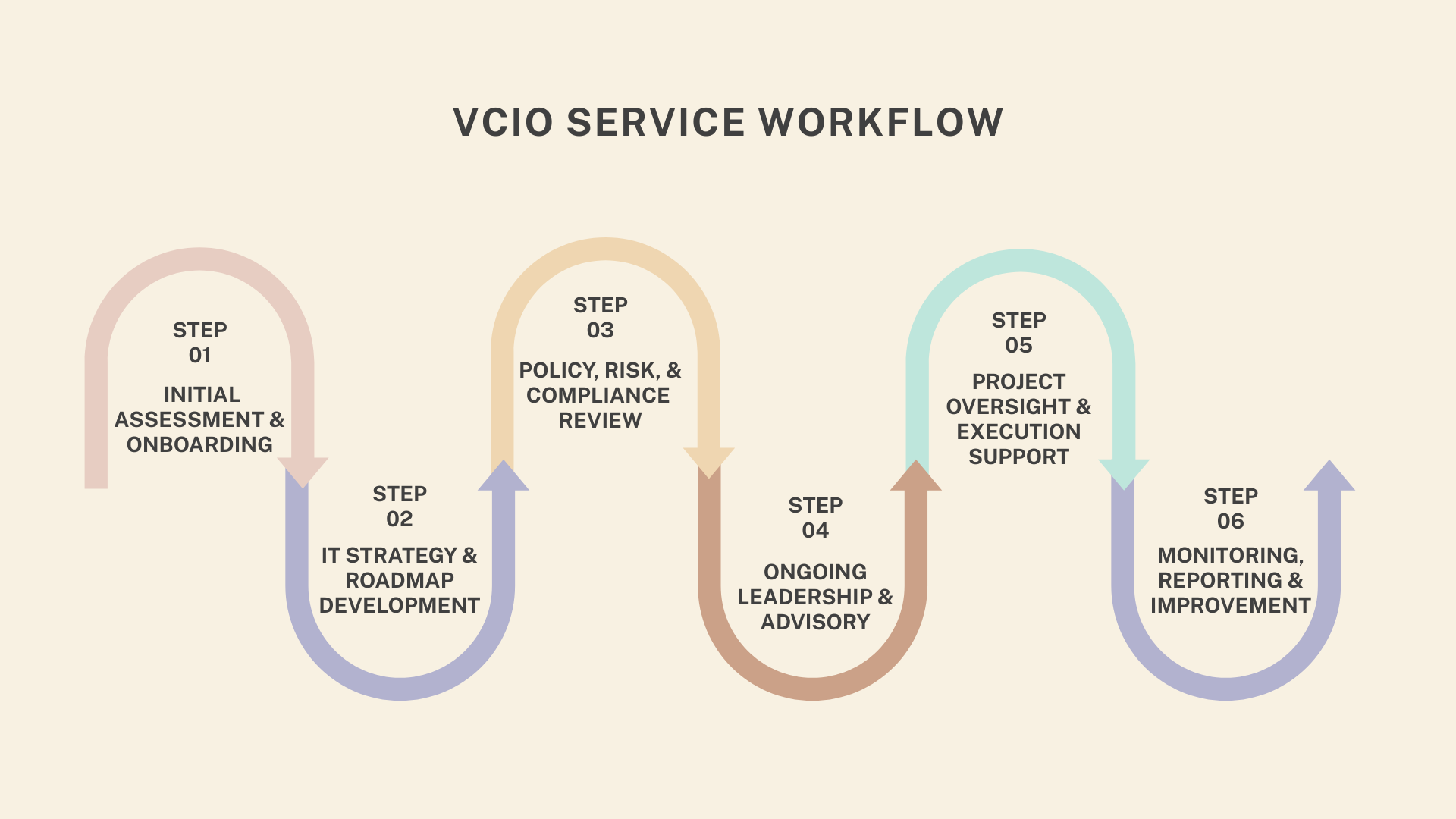What is a vCIO service?
As your business grows, your technology needs become more complex. You may find yourself needing strategic IT advice – but hiring a full-time Chief Information Officer (CIO) can be expensive. That’s where a Virtual CIO (vCIO) makes sense.
A vCIO gives you access to high-level IT strategy and leadership without the cost of a permanent executive. Think of them as your go-to technology advisor, helping you make smart decisions and align tech with your business goals.
What is a vCIO?
A Virtual Chief Information Officer (vCIO) is an external IT consultant who offers strategic guidance,much like a traditional CIO, but on a flexible or part-time basis. They work with your leadership team to plan your IT future, manage risks, and ensure your technology supports the direction of your business.
Unlike a traditional CIO, a vCIO isn’t on your payroll. Instead, they’re brought in as needed, often by small to medium-sized businesses looking for experience without the full-time salary.

A vCIO focuses on the big picture. Their role is to make sure your IT decisions support your business goals. Key responsibilities include:
- Technology planning – Developing an IT roadmap to match your future growth
- Budget forecasting – Helping you spend wisely on the right tech
- Cybersecurity strategy – Identifying risks and building resilience
- Compliance support – Making sure your IT meets industry regulations
- Technology audits – Reviewing your systems for inefficiencies and gaps
- Vendor management – Ensuring you get value from IT suppliers
- Leadership input – Advising owners and directors on IT-related decisions
- Cloud migration – Guiding secure transitions to cloud environments
- Digital transformation – Overseeing major change initiatives and new technology adoption
- Audit remediation – Addressing findings from compliance or risk audits
- Change management – Supporting the people-side of tech rollouts
- IT governance – Creating structures and policies for responsible IT decision-making
- Board-level reporting – Presenting performance and risk summaries to executive stakeholders
They don’t just put out fires, they help you avoid them altogether.
Many businesses already work with a Managed Service Provider (MSP). An MSP looks after your day-to-day IT support – like patching, backups, help desk, and updates.
A vCIO, on the other hand, works at a strategic level. They help plan your future, reduce risks, and guide major decisions. While MSPs focus on operations, vCIOs focus on outcomes.
Ideally, your vCIO and MSP should complement each other.
| Feature / Factor | Virtual CIO (vCIO) | Traditional CIO |
|---|---|---|
| Employment model | External consultant or on-demand partner, not a direct employee | Full-time, in-house executive and organisation staff member |
| Cost structure | Flexible: retainer, project, or hourly basis; scalable to need | Fixed, high salary; includes benefits and overheads |
| Location & presence | Typically remote or hybrid (occasional onsite); works across clients | On-site and fully present at company premises |
| Level of commitment | As required (part-time, fractional, interim, or by project) | Full-time commitment to one organisation |
| Scope of involvement | High-level strategy, IT roadmap, best-practice consulting, steering large projects; not typically involved in daily IT ops | Deeply engaged in business operations and daily IT management |
| Expertise & perspective | Broad industry experience, draws from working across sectors, objective advice | Deep specialist knowledge of one business, internal perspectives |
| Ability to scale | Easily adjusts involvement up/down based on business needs; no long-term lock-in | Less flexible, fixed overhead regardless of business phase |
| Functionality | Technology strategy, budgeting, vendor management, cyber risk, compliance, digital transformation, objective/pluralistic outlook | All the above, plus direct team management, 24/7 organisational oversight |
| Reporting lines | Reports to business owners, directors, or executive committee as a consultant | Reports internally (to CEO/executive team/board) |
| Objectivity | Less internal politics, brings fresh perspective and industry benchmarks | Could be more influenced by company politics and status quo |
| Ideal for | Small to medium businesses, scaling organisations, companies needing executive input but not full-time | Larger organisations with continual, complex, daily IT needs |
| Onboarding time | Rapid (can start on short notice or for projects) | Typically requires full executive recruitment cycle |
- Clarity – Know where your IT is headed and why
- Confidence – Make decisions backed by strategy
- Security – Build strong cyber resilience
- Cost control – Plan budgets and avoid surprise bills
- Leadership – Have an expert voice at the table
A good vCIO helps you be proactive, not reactive. They bring clarity, confidence and calm to your IT decisions.
Hiring a full-time CIO in Australia can cost upwards of $200,000 a year. For most small or medium-sized businesses, that’s just not practical.
A vCIO typically works on a monthly retainer or project basis. You get executive-level insight for a fraction of the cost, with flexible hours to match your needs.
You might benefit from a vCIO if you:
- Feel unsure about your IT direction
- Have no clear tech roadmap
- Rely on an MSP but lack strategy
- Want to grow but need scalable tech support
At Intech3, we provide vCIO services tailored to Australian businesses that want more than just IT support. We help you build smarter systems, reduce risk, and plan for the future.
Checklist for Australian SMEs
Use this checklist to quickly assess if your business could benefit from a Virtual Chief Information Officer (vCIO) partnership.
1. Strategic IT Direction
- Our business has clear growth goals, but no strategic technology roadmap.
- We lack in-house IT leadership at the executive level.
- Technology decisions are made reactively, not proactively.
2. IT Performance & Risks
- We’ve experienced repeated IT issues or costly downtime in the last 12 months.
- Our cybersecurity approach is basic or untested.
- Compliance requirements (industry, privacy, etc.) are growing but unclear.
3. Budgeting & Value
- IT costs are unpredictable or difficult to plan for.
- There’s uncertainty about whether we’re getting value from technology investments.
- Large IT projects or purchases often run over budget or miss ROI targets.
4. Resource and Skills Gaps
- Our IT support covers day-to-day issues, but can’t provide strategic advice.
- We lack expertise for digital transformation, cloud migration or major upgrades.
- Technology is holding back business innovation or customer experience.
5. Vendor & Project Management
- Managing multiple IT vendors is time-consuming or confusing.
- Past IT projects have suffered from delays, overruns, or unclear outcomes.
6. Leadership Confidence
- We’d benefit from an objective, outside perspective on our IT posture.
- There’s no IT voice at board/executive level discussions.
- Leadership sometimes feels “in the dark” about technology or risk matters.
If you ticked ANY of these boxes, you’re likely to benefit from vCIO services.
A vCIO gives you strategic, executive-level IT advice, without the cost of a full-time hire.
What is a Virtual CIO (vCIO)? A vCIO is an outsourced technology strategist who provides high-level IT guidance to businesses on a flexible or part-time basis. They offer the same value as a traditional CIO, but without the cost or commitment of a full-time executive.
How does a vCIO differ from a traditional CIO? The key difference lies in delivery. While a CIO is a full-time internal leader, a vCIO is an external advisor brought in as needed. vCIOs offer more flexibility and cost-efficiency, and often have broader experience across different industries.
Is a vCIO the same as an MSP or IT support provider? No. MSPs focus on operational IT tasks like maintenance and support. A vCIO provides strategic oversight, helping align technology decisions with business goals. They often work in partnership with MSPs.
Which types of businesses benefit most from vCIO services? vCIOs are ideal for small to mid-sized businesses that want executive-level IT direction but don’t have the budget or need for a full-time CIO. They’re especially useful for organisations navigating growth, digital transformation, or regulatory change.
What specific tasks or services does a vCIO provide? Typical vCIO services include IT strategy, cloud migration, budgeting, digital transformation planning, vendor management, governance structuring, compliance oversight, board reporting, and risk management.
Can a vCIO work alongside my current MSP? Yes. In fact, most vCIOs regularly collaborate with a client’s existing MSP. While the MSP handles the daily IT operations, the vCIO provides strategic direction and long-term planning.
How quickly can a vCIO start adding value? Many vCIOs start delivering insight from day one. Their first step is typically a technology audit or strategy session, which quickly identifies priority areas for improvement.
What’s included in a typical vCIO engagement? Engagements vary, but most include strategic IT planning, regular management meetings, cybersecurity oversight, compliance support, and executive reporting. Some may also include workshops or project-based services.
How do I choose the right vCIO for my industry niche? Look for a provider with experience in your industry and a strong understanding of its regulatory and operational challenges. Ask for references and make sure their approach aligns with your company culture and growth plans.
Let’s talk.
Get in touch to see how Intech3 Virtual CIO services can help your business move forward with confidence.
Other news & insights
AI Readiness: How to Prepare Your Business
AI readiness means preparing your organisation strategically, technically, and culturally so AI delivers measurable value.
Learn MoreWhat is an MSP Service Level Agreement (SLA)?
Let’s break down what an MSP SLA actually involves, why it matters, and how to make sure yours is set up for long-term success.
Learn More

